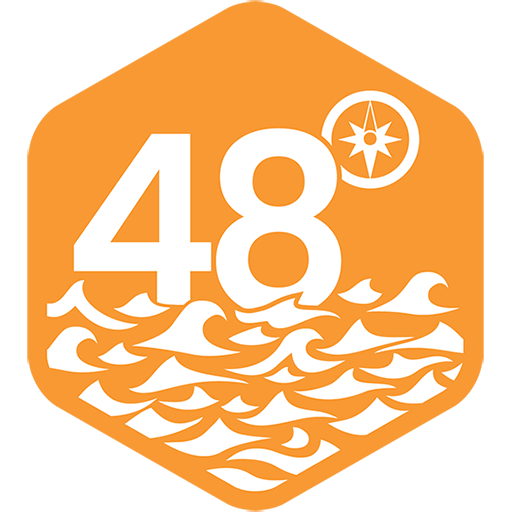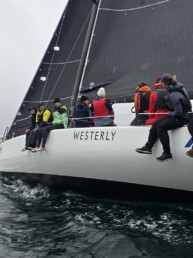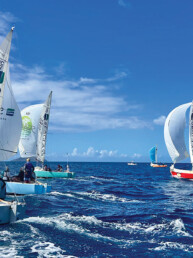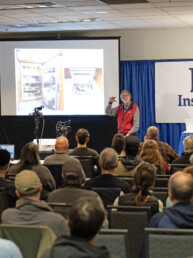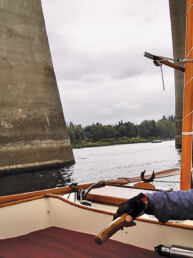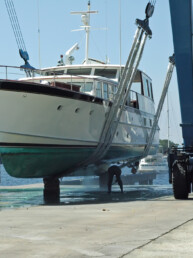This article was originally published in the November 2021 issue of 48° North
It happens whenever I row up to an anchorage or dock around dusk; heads turn, as sailors of cabin boats scrutinize Row Bird and me. Of course, I always hope they’re noticing my careful scanning of the scene, my skillful approach, or the anchors and mooring lines well organized and ready in my open cockpit. But I’ve been through this routine often enough to know what’s truly on the minds of my fellow boaters: The Question. Sometimes they ask it even before saying hello or helping me with my lines. It’s been posed so frequently that I can tell when someone’s going to spring it on me—and someone always does.
Are you going to sleep on that thing?
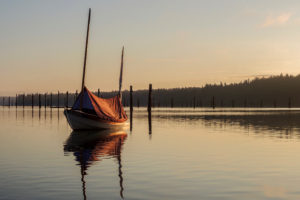 The answer, for me and lots of other small boat folks, is a resounding, “Yes!” As any cruising sailor knows, there’s magic in sleeping aboard, whether on the hook or bobbing alongside a pier. Sleeping on a just-big-enough sailboat allows me to overnight in places I couldn’t enjoy if I had to camp ashore, or if I was restricted to deeper anchorages, like a keelboat.
The answer, for me and lots of other small boat folks, is a resounding, “Yes!” As any cruising sailor knows, there’s magic in sleeping aboard, whether on the hook or bobbing alongside a pier. Sleeping on a just-big-enough sailboat allows me to overnight in places I couldn’t enjoy if I had to camp ashore, or if I was restricted to deeper anchorages, like a keelboat.
Eighteen-foot Row Bird and her ilk are small enough to slip into the overlooked, in-between spaces: the gap at the dock too small to fit a family boat; the near shore zone too shallow for a keelboat, but too deep to leave a tender. Us small boat mariners nose into thin water bays and coves inaccessible to any captain who fears touching bottom. When I arrive for the night aboard Row Bird, there’s always room for me.
I recall nights spent in a rocky nook just feet from the beach, where only dinghies would dare to go. Sometimes, after carefully surveying the bottom, I’ve set a bow and stern anchor, intentionally allowing my boat to sit on the hard with a falling tide, for a peaceful night. Other times, when I find no shallow water, I anchor in 30 feet like my deep-draft brethren, an unfamiliar situation that I am strangely uncomfortable with, despite its relative safety.
Setting up my “cabin” for the night takes about five minutes. Once Row Bird is secured to a dock or by anchor, I slide my furled tent out of its bag. Clipping a lead to the main mast, I unroll its waterproof fabric and cinch the other end to the mizzen mast; then I tie down three internal battens, transforming my cockpit into a Conestoga style wagon on the water. Next, I move all my gear to the port side of the boat, dry the floorboards with my trusty sponge, lay out a camping pad and sleeping bag on the starboard side, and I’m ready for a good night’s sleep.
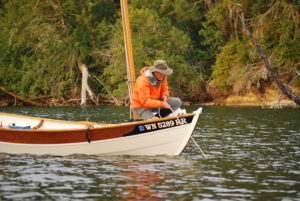 I’ve seen other small craft cruisers perform similar routines with varying degrees of complexity…and success. One sailor I know commissioned a clamshell-like bimini top for his 14-foot sailboat, complete with aluminum struts and clear plastic windows. Another friend takes a more rustic, yet functional approach on his micro-cruiser — a canvas painter’s drop cloth pulled over the boom and draped over either gunwale. The variations are endless and can be constructed from an elegantly cut piece of Sunbrella fabric, or consist of a simple blue poly tarp pulled over a sleeping bag in the cockpit. The end result is (hopefully) the same: a pleasant way to overnight.
I’ve seen other small craft cruisers perform similar routines with varying degrees of complexity…and success. One sailor I know commissioned a clamshell-like bimini top for his 14-foot sailboat, complete with aluminum struts and clear plastic windows. Another friend takes a more rustic, yet functional approach on his micro-cruiser — a canvas painter’s drop cloth pulled over the boom and draped over either gunwale. The variations are endless and can be constructed from an elegantly cut piece of Sunbrella fabric, or consist of a simple blue poly tarp pulled over a sleeping bag in the cockpit. The end result is (hopefully) the same: a pleasant way to overnight.
My system works pretty well, although I’ve seldom spent an evening afloat without thinking of a way to make it better. I tend to sprawl when I’m ensconced for the night. Changing from sailing duds to sleeping clothes, getting out food, and retrieving books and headlamps all require digging into nearly every drybag and hatch on the boat. By bedtime, Row Bird looks more like a teenager’s room than a respectable self-propelled vessel, with clothes, gear, cooking supplies, and bedding all in a jumble. But once darkness comes, I feel just as comfortable in my mess as any teenager in her lair.
I confess that every night afloat in a small boat isn’t a great time. Wind is seldom a problem; rain usually only makes a pleasant soundtrack. It’s the currents and waves that really get to me. Lacking a heavy hull or ballast, Row Bird can rock end to end and side to side seemingly all at once, producing a nauseating sensation. An errant motorboat’s wake striking abeam after I’m asleep can be so shocking that I bolt upright, completely disoriented for hours afterwards.
But more often than not, sleeping aboard is fun, cozy, and safe. By the time the evening is over, I’ve often been invited aboard a bigger boat for dinner or a morning cup of coffee. What starts out as curiosity usually ends in camaraderie, because no matter the size of the boat or the accommodations, we’re all out for the same reasons: to enjoy the quiet of a protected anchorage, feel the warmth of the morning sun, hear the cackle of a gull — and of course, to sleep in our bunks on the water.
Bruce Bateau
Bruce Bateau sails and rows traditional boats with a modern twist in Portland, Ore. His stories and adventures can be found at www.terrapintales.wordpress.com
